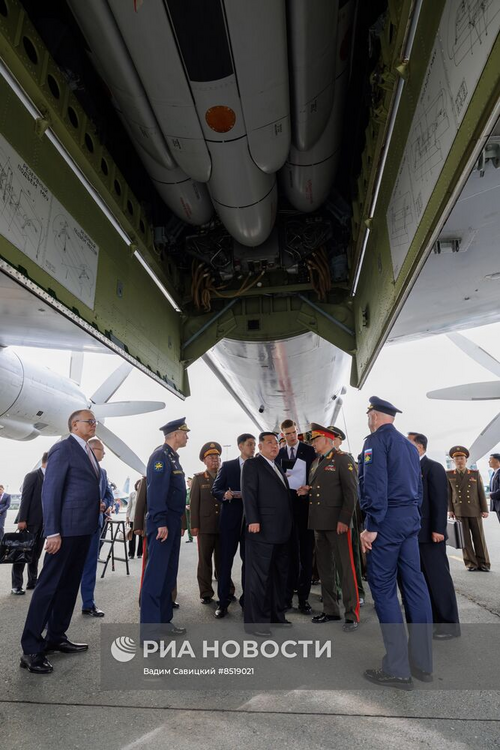D
Deleted member 2278
Guest
Only if I can get in on the centre-barrel replacement contract!...or they could hire back Pougachev to make a cobra manoeuver: except with a Tu-160 rather than a Su-27.
Only if I can get in on the centre-barrel replacement contract!...or they could hire back Pougachev to make a cobra manoeuver: except with a Tu-160 rather than a Su-27.
Command guidance is the worst option for such a task on such a platform. Additionally, it would demand two radars, for observation and illumination/guidance. No chance it will be Tor or something like it. A derivative of R-74M is the most likely variant, IMO.If true I wonder if it will be a Tor type missile.
Modernized Tu-160M "Igor Sikorsky" is equipped with dummies of DIRCM system which included UV-sensors and laser turrets.Antimissiles are along with DIRCM and EW the future for aviation active protection systems. Though I'm hesitant on this as well, it does make sense that a big high value missile carrier like tu160 would be equipped with small missiles capable of defeating enemy missiles or even enemy aircraft in very close range. If true I wonder if it will be a Tor type missile.
In the end we were just waiting for all the speculation about self defence missiles to see actual deployment, I don't know if this will be the first case but it indeed makes sense to protect high value and strategic assets with all the technologies that are already available. To what extent this would allow to operate in highly protected environments is an interesting question, once VKS has traditionally opted for stand-off release of missiles rather than for direct bombing. The Tu-160 is an strict strategic missile carrier, but PAK-DA may take those self defence technologies even further, allowing its use even for tactical bombing in non-permissive environments.Strange news come from the "source in aviation industry", according to RIA Novosti.
Tu-160 got the rear-looking radar and will carry A2A missiles capable to hit enemy missiles and aircraft.
G-translated article on RIA website.

Ehh? It makes perfect sense: the rear radar will update the missile, probably a LOAL, even capable to be an interceptor (like IRIS-T can hit incoming missiles.)Strange news come from the "source in aviation industry", according to RIA Novosti.
Tu-160 got the rear-looking radar and will carry A2A missiles capable to hit enemy missiles and aircraft.
G-translated article on RIA website.
A smallish missile (which it'd have to be^1) has highly limited propellant, how would it negate the (negative, for the missile) already present forward momentum? Does it have a parachute that slows it down before it jets away in a new direction?
Hah. Rear radar seems perfectly fine, but I'm sure somebody has misinterpreted the nature of some kind of more plausible
countermeasures.
^1 Where'd they install it? A smallish missile (eg MANPADS-like in a tube inside the body is how I interpret this fantasy), or a huge missile installed backwards in the rotary bays . The latter has better eh, kinematics at least, sure. But that at the expense of its offensive payload, and I mean, say what?
Just wondering what is the name of the Tu-160 in the photo, I know that they have names from the engine manufacturer all the way to the chief designer.
Just wondering what is the name of the Tu-160 in the photo, I know that they have names from the engine manufacturer all the way to the chief designer.Veremey Boris, photo, biography
persona.rin.ru
They will, I presume.One further question what will happen to the new build Tu-160s? Will they carry on with the tradition?
Very unexpectedAnother Tu-160M upgrade at KAPO?
Yeah then KAPO got their Ruble and VKS got their bomber.Very unexpectedAnother Tu-160M upgrade at KAPO?. This plane belongs to the "Tupolev" design bureau. At least it was. Now, judging by the painting, it belongs to the Air Force.
Nice. So that is 3 additional air-frames to VKS fleet since fleet renewal program began.Very unexpectedAnother Tu-160M upgrade at KAPO?. This plane belongs to the "Tupolev" design bureau. At least it was. Now, judging by the painting, it belongs to the Air Force.

Second newly builded Tu-160M and another one modernized are begins ground trials
View: https://youtu.be/xaX7q4H_mlY

Два стратегических ракетоносца Ту-160М переданы на лётно-испытательную станцию
Новости дочерних компаний ОАК, новости ДЗОuacrussia.ru
Also
First newly builded Tu-160M continued flight tests, now with fully-operational DIRCM system
No, it is impossible.Would they carry GPS guided weapons?
No, it is impossible.Would they carry GPS guided weapons?
Don't know what you think of, but it is impossible to use any GPS-systems on Russian weapon-systems, only GLONASS.No, it is impossible.Would they carry GPS guided weapons?
Thanks QuadroFX, so it is just going to be a missile carrier, that is a shame.
Don't know what you think of, but it is impossible to use any GPS-systems on Russian weapon-systems, only GLONASS.No, it is impossible.Would they carry GPS guided weapons?
Thanks QuadroFX, so it is just going to be a missile carrier, that is a shame.
How do you think you reacted if anybody asking about using GLONASS-guided weapons on B-1B? Pff.
Kh-BD, Kh-SD, former "Raduga" design buro hypersonic missile. Presumably of course.what sort of guided weapons will the new modernised Tu-160s carry?
Your phone is probably newerI'd expect most GPS weapons to be able to use any of the various constellations (Navstar, GLONASS, Galileo, BeiDou, etc.) since all it takes is slightly different software. My phone can use multiple GPS networks, why not a missile? With the obvious caveat that the encrypted precision signals (P(Y) for Navstar) are not available to all users.
I'd expect most GPS weapons to be able to use any of the various constellations (Navstar, GLONASS, Galileo, BeiDou, etc.) since all it takes is slightly different software. My phone can use multiple GPS networks, why not a missile? With the obvious caveat that the encrypted precision signals (P(Y) for Navstar) are not available to all users.
IIRC original news article didn't state that particular missile in the bay was Kh-BD with a range of 6500 km. It stated there is such a missile in Tu-160 arsenal. I might be wrong but this is how i understood it.Nah not if the source is correct. The missile was stated to have a range of about 6500 klicks. And about ruskies using western satellite navigation it is a good question. I think there are multiple reasons. Increasing accuracy particularly in areas where glonass might not have solid coverage. I also agree with the other potential reasons previously mentioned above.
Nah not if the source is correct. The missile was stated to have a range of about 6500 klicks. And about ruskies using western satellite navigation it is a good question. I think there are multiple reasons. Increasing accuracy particularly in areas where glonass might not have solid coverage. I also agree with the other potential reasons previously mentioned above.

'Strange source' is Commander of the long-range aviation Lieutenant General Sergei Kobylash. And unblurred photo shows the other missile and other type of plane.
